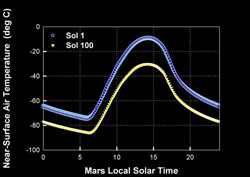
The temperatures expected at the rover now, in blue, and in 100 days in yellow.
What's new on Mars
We'll look at the images returned by the Spirit Mars lander and try to figure out what they are telling us about water on Mars.
The Landing
the Spirit Rover landed on Mars at 14 degrees south latitude, and 175 degrees longitude. The Opportunity Rover is aiming to land on the exact opposite side of the planet near 0 degrees latitude and 0 degree longitude. Near the equator and the prime meridian, which is why the landing site is named meridiani planum.
Scientists used the Doppler shift of radio signals from Spirit received by orbiting spacecraft, Mars Global Surveyor and Mars Odyssey to determine the location of the Spirit Rover on the surface to within about 10 meters of error. They used images taken from the orbiters and from the landing cameras on Spirit itself to locate Spirit on the surface. They found that they had landed just 250 meters from a 200 meter diameter crater. A crater probably tens of meters deep and with a 4 meter high raised rim. There are hills 3 km away. Mission scientists plan to send the rover to the crater, then toward the hills. This will allow them to look down into the layers beneath the surface of Gusev crater, and then to look up at layers above the surface. If they just drove without doing any science they can drive 50 meters a day, so it will take at least 5 days to drive to the crater and 60 days to drive to the hills. They don't expect to reach the hills but they will get better views as they get closer.
The lander was cut loose from the parachute at just 8.5 meters above the surface of Mars, just 1.5 airbag diameters, much closer to the surface than planned. This was all done automatically by the program loaded into the lander. As they followed the landing scientists noted that "robots have nerves of steel...well actually copper." The first bounce of the airbags brought the lander up to an elevation of 8.4 meters. They think this high bounce was the result of residual horizontal velocity, the kinetic energy of this sideways motion added to the height of the first bounce. The lander then bounced 28 more times before coming to rest near sleepy hollow.
The Weather
Weather forecast for Mars Spirit Lander sol 10,
Summer is landing so we predict that temperatures
will become cooler.
The atmospheric dust will decrease.
Ice clouds will appear.
Of course, this is Mars and we always expect surprises.
Personally I think that the prediction that it will get cooler as summer ends is unlikely to reveal many surprises.
Anyone who has hiked in the deserts of earth knows that when the day ends it gets cold. Mars is a desert and it does get cold at night. here are the predicted temperatures of the air near the surface of Mars at the beginning of the mission during the Martian summer and after 100 days as fall begins.

The temperatures expected at the rover now, in blue, and in 100 days
in yellow.
Eventually, if nothing else kills the Spirit Rover, the cold temperatures of winter will kill at by destroying its batteries.
On January 15 the high temperature on Mars was 12°F, which was warmer than the high temperature in Boston of 8°F.
The coldest temperature at night on Mars was -70°C or -100°F, as cold as the coldest temperatures recorded in Siberia or in the middle of the Antarctic ice cap in winter.
The temperature on Mars depends on the altitude. It gets colder rapidly as you go up. Your feet could be at 80°F while your head is at 0°F. At least the temperature would be great at your belly button.
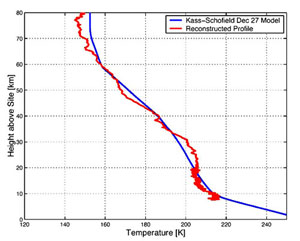
The temperer on Mars as a function of altitude. Click to
enlarge.
The Photographs
Here is the mission success panorama taken by the Spirit rover on Mars.

Here is the full panorama of the landing site photographed by the
Spirit Rover. Click to enlarge.
This 100 megapixel image was taken one megapixel at a time by the Pancam.
The thermal emission spectrometer sent back data on the temperature and composition of rocks around the spirit lander site.
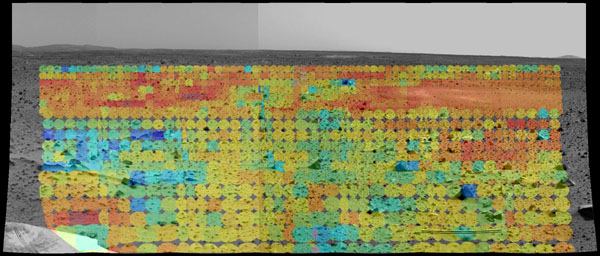
In this image the TES data is placed over a lander pancam
image. The colors indicate the temperatures of the surface. In this
daytime image the rocks are shown in blue representing cooler
temperatures (up to 10 °C cooler than average, while dust is red
and is up to 10°C warmer.
TES also took spectra of the infrared radiation emitted by the surroundings. In the following image the spectra is shown in yellow. Spectra of the site from orbit are shown in red.
Notice the middle wavelength here is 10 micrometers, over ten times the wavelength of red light, and ten times smaller than the diameter of a human hair. The dips in the spectra represent absorption by different minerals. This data shows the presence of silicates, and carbonates in the rock as well as, carbon dioxide in the atmosphere and even water.
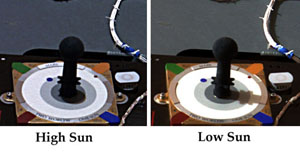
Images were sent back of the sundial on the spirit lander, it is also
a color calibration target. Notice how scattering of light from the
sky fills in the shadow of the gnomon. Skylight is about equal to the
brightness of direct sunlight on Mars, so the shadow is darker by
about one f-stop, a factor of two in photographic exposure
terms.
There is not much in this image to interest a rock climber. There is a range of mountains in the distance, perhaps they have some good climbing cliffs?
The Soil
Landing
3-D
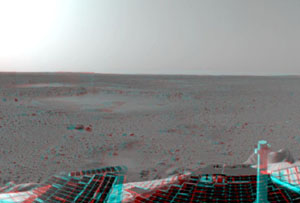
You will need red/green glasses to see the 3-d effect. Click
to enlarge. JPL
Sunset
Here is the first panorama from the spirit lander in Gusev crater

The first view of Gusev Crater from the Spirit Lander. It's
near sunset. Click to enlarge.
|
Scientific Explorations with Paul Doherty |
|
15 January 2004 |